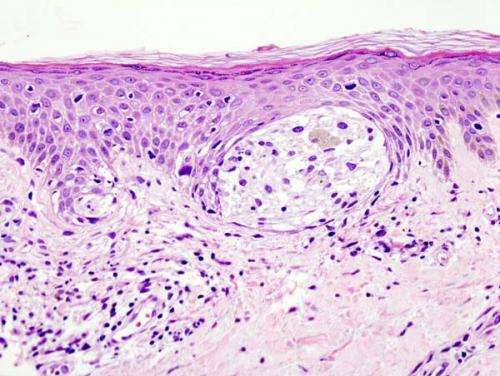Drugs designed for prostate cancer show promise for treating melanoma in men

New research shows that testosterone promotes melanoma proliferation by activating a newly recognized nonclassical testosterone receptor in melanoma cells called ZIP9 (encoded by the SLC39A9 gene), a zinc transporter that is not intentionally targeted by any available therapeutics but is widely expressed in human melanoma. The new study from researchers at the Perelman School of Medicine at the University of Pennsylvania uses melanoma models in mice to show that drugs that target androgen receptors (AR) in prostate cancer can be effectively repurposed to block ZIP9 and thereby inhibit melanoma in men. The findings were published today in the journal Cancer Research.
Melanoma and most other cancers occur more frequently and yield worse outcomes in men than in women. The American Cancer Society estimates about 106,110 new melanomas will be diagnosed (about 62,260 in men and 43,850 in women) in the United States in 2021, and about 7,180 people are expected to die from the disease (about 4,600 men and 2,580 women). While this sex difference has been recognized for decades, the reasons for the difference have largely remained elusive. While sex steroids are thought to be involved, the classical androgen and estrogen receptors generally considered necessary for sex steroid effects are not detectable in most melanomas.
“The male sex hormone testosterone increases the rate of melanoma cell proliferation because it acts through ZIP9 rather than through the classical testosterone receptors that are well studied in prostate cancer,” said senior author Todd Ridky, MD, Ph.D., an associate professor of Dermatology at Penn. “While there are no approved drugs that inhibit ZIP9, structurally related drugs such as apalutamide that block the classical testosterone/androgen receptor in prostate cancer, when given to mice with melanoma, slowed tumor growth and extended survival, but only in males.”
This discovery regarding ZIP9 is likely applicable to most human melanomas. The study looked at 98 human melanocytic lesions (regular moles, as well as primary and metastatic melanoma from both males and females). Nearly all samples expressed lots of ZIP9, while the classical testosterone receptor was not detectable in any of them. ZIP9 is also expressed in many other human tissues, suggesting that this discovery in melanoma may be broadly applicable to many cancer types.
This study is the first to show that ZIP9 is a determinant of the male vs. female disparity in cancer, and establishes a novel mechanistic link between male androgens and melanoma pathobiology. These findings also build on prior work from the Ridky lab at Penn, where researchers have shown that estrogen signaling through a nonclassical estrogen receptor called G protein-coupled estrogen receptor (GPER) suppresses melanoma and other cancers.
Source: Read Full Article



